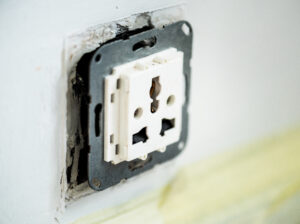Electrical fire warning signs are often overlooked, yet they represent a considerable threat to homeowners. These fires frequently begin as minor issues, possessing the potential to inflict catastrophic damage in a matter of seconds. Gaining insight into these early warning indicators can be crucial in averting calamity. This article seeks to provide you with the essential information required to recognize these indicators and respond proactively before disaster strikes.
Understanding Electrical Fire Warning Signs
Electrical fires commonly initiate from subtle cues, often referred to as electrical fire warning signs, indicating that an issue is present. These warning signs serve as an essential communication for homeowners regarding underlying matters that necessitate attention. Ignoring these alerts can result in grave consequences, including damage to property, injury, or even the loss of life. By recognizing and understanding these indicators, homeowners can avert potential dangers and uphold a safe living environment.
Failure to address these indications can result in rapid escalation. For instance, a seemingly minor flicker in your lighting may ultimately lead to a significant electrical fire if neglected. Acknowledging and acting upon these signs is paramount, as they represent the initial protection for your home and family.
Flickering or Dimming Lights
 Unstable lighting is not merely an inconvenience; it may signal significant electrical issues. Flickering or dimming lights frequently imply problems with wiring or circuits that are overloaded. When a circuit is unable to manage the electrical load efficiently, it experiences difficulties in providing a consistent light output. Such variations can lead to unexpected flickering or dimming of lights.
Unstable lighting is not merely an inconvenience; it may signal significant electrical issues. Flickering or dimming lights frequently imply problems with wiring or circuits that are overloaded. When a circuit is unable to manage the electrical load efficiently, it experiences difficulties in providing a consistent light output. Such variations can lead to unexpected flickering or dimming of lights.
Such irregularities must be treated with utmost seriousness, as they can result in overheating and may pose a fire risk. If you frequently notice this, particularly when utilizing large appliances, it is essential to seek professional advice. Early intervention can help transform a trivial concern into a safe and manageable situation.
Burning Smell
The detection of a burning odor with no identifiable source is an urgent warning that must not be disregarded. This smell often originates from melting wires or excessively heated electrical components. When wiring sustains damage, it can become sufficiently hot for the plastic insulation to melt, leading to the release of a notable burning smell.
When an odor is detected, it is vital to respond with urgency. Unplug any suspicious devices and, if appropriate, switch off the power at the main breaker. Prompt action may mitigate the risk of escalation; nevertheless, it is important to arrange for a licensed electrician to investigate your system and pinpoint the underlying issue.
Discolored or Warm Wall Outlets
The presence of heat damage in electrical outlets, indicated by discoloration or warmth upon contact, frequently serves as a warning sign of defective wiring. Overheating of outlets may arise from an excessive flow of electricity through a circuit, resulting in the combustion or melting of adjacent materials. If this situation is not addressed, it poses a significant risk of fire.
Regularly evaluating outlets for discoloration or warmth is essential. If you notice any signs of trouble, you should stop using the outlet right away and contact a professional for an in-depth assessment. By ensuring your outlets operate safely, you can greatly decrease the potential risk of an electrical fire.
Frequent Circuit Breaker Trips
Designed to cease electrical flow during overload situations, circuit breakers play a crucial role in electrical safety. Regular tripping of your breaker points to an electrical system that cannot manage the imposed demands effectively. This can stem from issues such as short circuits, circuit overloads, or wiring defects.
Although it is not unusual for a breaker to trip on occasion, consistent tripping should be taken seriously. Engaging an electrician to inspect your system is vital in order to pinpoint the cause of the overload and to implement the required solutions. Acting now can mitigate the risk of encountering more serious electrical issues in the future.
Buzzing or Crackling Sounds
Uncommon auditory signals, such as buzzing or crackling, originating from electrical outlets or appliances should not be overlooked. Such sounds frequently suggest the occurrence of electrical arcing, which involves electricity leaping across connections, generating heat and potentially igniting adjacent materials.
Hearing these sounds necessitates immediate action. Unplug any devices that could be affected and avoid using the outlet until it has been assessed. Electrical arcing is a grave concern, but prompt measures can help prevent the outbreak of a fire.
Sparks From Outlets or Appliances
Observing sparks coming from outlets or appliances is a concerning occurrence that signals significant electrical problems. Such sparks may arise from overloaded circuits, compromised wiring, or improper installations. They present an immediate fire hazard and necessitate prompt intervention.
If you see sparks, immediately cease using the outlet or appliance and, if safe, turn off the main power supply. Contact a certified electrician to do a comprehensive check and resolve any concerns. Quick intervention is critical for avoiding future difficulties.
Frayed or Damaged Cords
Using appliances with frayed or compromised cords can be a hazardous endeavor. Exposed wires significantly elevate the risk of electrical shock and fire. Such deterioration can stem from regular use, pet activity, or improper care, highlighting the necessity of regularly examining the condition of your cords.
Replace or repair damaged cords as soon as they are noticed. Avoid using makeshift solutions like tape to cover exposed wires. Investing in cord replacements is a small price to pay for ensuring the safety of your home.
Hot Ceiling Fixtures
It is important to recognize that ceiling fixtures which become excessively warm are often ignored, yet they can pose serious threats. Overheating can result from using bulbs with wattage that exceeds the recommended levels or from insufficient ventilation. Such heat can ignite insulation or other combustible materials nearby.
Check your ceiling fittings for warmth on a regular basis, and make sure the bulb wattage is within manufacturer requirements. If you discover bulbs that are too hot to touch, consider replacing the bulb or having the fixture examined by a specialist.
Non-Functioning Outlets

While a non-operational outlet may initially seem like a minor hassle, it can actually indicate deeper electrical issues.
Such outlets may suggest problems with the wiring, a tripped breaker, or potentially a more critical fault.
Rather than ignoring the issue, have the outlet inspected to determine the cause. Addressing these problems can prevent further electrical complications and improve the safety of your home.
Unusual Odors from Appliances
Strange smells emanating from appliances can signal overheating components. When motors or wiring are pushed beyond their limits, they can emit odors as they heat up, posing a risk of fire.
Upon detecting any strange smell, please disconnect the appliance and discontinue its use until it has been evaluated. Consistent maintenance and compliance with usage recommendations are effective measures to prevent these complications.
What to Do if You Notice These Signs
Observing any of these warning signs should prompt immediate action. Begin by switching off the power and unplugging any involved devices. It’s crucial to consult a licensed electrician to perform a thorough inspection and address any discovered issues.
Undertaking DIY repairs can introduce considerable risks, possibly intensifying the problem or causing harm. It is prudent to seek the assistance of qualified professionals, ensuring that repairs are carried out with safety and effectiveness in mind, which in turn fosters peace of mind while enhancing the safety of your residence.
Tips for Preventing Electrical Fires
Proactive maintenance and inspection of your home’s electrical framework are fundamental to fire risk reduction. It is advisable to consult a certified expert for yearly inspections and to maintain safe usage practices for all your appliances and devices. Additionally, verify that smoke detectors are adequately installed and in full working condition throughout the premises.
Consider installing surge protectors to protect your gadgets against power spikes. By being proactive and watchful, you may dramatically minimize the danger of electrical fires, therefore safeguarding your house and family.
Conclusion
Electrical safety must be regarded with utmost seriousness. Identifying and reacting to electrical fire warning signs can significantly influence the distinction between safety and catastrophe. For homeowners, especially those who may need to sell a fire-damaged house, understanding these warning signs is essential to ensuring safety and maintaining property value. Through awareness and proactive measures, homeowners have the ability to foster a safe living space for themselves and their loved ones.
Encourage others to remain vigilant and spread awareness about electrical safety. A few precautionary measures today can prevent significant challenges tomorrow. Stay safe and informed—your home depends on it.
Previous